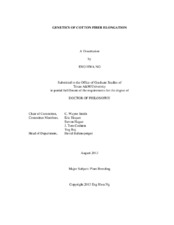| dc.contributor.advisor | Smith, C. Wayne | |
| dc.creator | Ng, Eng Hwa | |
| dc.date.accessioned | 2013-12-16T19:59:44Z | |
| dc.date.available | 2015-08-01T05:48:25Z | |
| dc.date.created | 2013-08 | |
| dc.date.issued | 2013-05-29 | |
| dc.date.submitted | August 2013 | |
| dc.identifier.uri | https://hdl.handle.net/1969.1/151034 | |
| dc.description.abstract | Fiber elongation (ability to stretch before breaking) is one of the key components in determining overall yarn quality. Elongation in U.S. upland cotton (G. hirsutum L.) has remained largely neglected due to: absence of monetary incentives for growers to produce high elongation cotton; lack of research interests among breeders; and absence of a reliable fiber testing system for elongation. This study was conducted to determine the genetics of cotton fiber elongation via a diallel and generation means analysis (GMA). Findings from this study should lay the foundation for future breeding work in cotton fiber elongation.
Of the seven distinctive upland parents used for the diallel study, general combining ability was far more prominent than specific combing ability for fiber elongation. Cultivar PSC 355 and Dever experimental line were the two parents identified as good combiners for fiber elongation in this study. The slight negative correlation between fiber elongation and strength remained true. Highly significant negative correlation was observed between fiber upper half mean length and elongation. Both Stelometer and HVI elongation measurements correlated well with values of 0.85 and 0.82 in 2010 and 2011, respectively. For the six families used in the GMA analysis, additive genetic control was prevalent over dominance effect. Based on the scaling test, no significant epistatic interaction was detected for fiber elongation. As expected, additive variance constituted a much larger portion of total genetic variation in fiber elongation than the dominance variance. On average, larger numbers of effective factor were identified in fiber elongation than all other fiber traits tested, suggesting that parents used in the GMA study are carrying different genetic materials/ loci for fiber elongation. Considerable gains in fiber elongation may be achieved by selectively crossing these materials in a pure-line breeding scheme while holding other important fiber traits constant. | en |
| dc.format.mimetype | application/pdf | |
| dc.language.iso | en | |
| dc.subject | Cotton | en |
| dc.subject | Fiber elongation | en |
| dc.title | Genetics of Cotton Fiber Elongation | en |
| dc.type | Thesis | en |
| thesis.degree.department | Soil and Crop Sciences | en |
| thesis.degree.discipline | Plant Breeding | en |
| thesis.degree.grantor | Texas A & M University | en |
| thesis.degree.name | Doctor of Philosophy | en |
| thesis.degree.level | Doctoral | en |
| dc.contributor.committeeMember | Raj, Yog | |
| dc.contributor.committeeMember | Cothren, J. Tom | |
| dc.contributor.committeeMember | Hague, Steve | |
| dc.contributor.committeeMember | Hequet, Eric | |
| dc.type.material | text | en |
| dc.date.updated | 2013-12-16T19:59:44Z | |
| local.embargo.terms | 2015-08-01 | |


